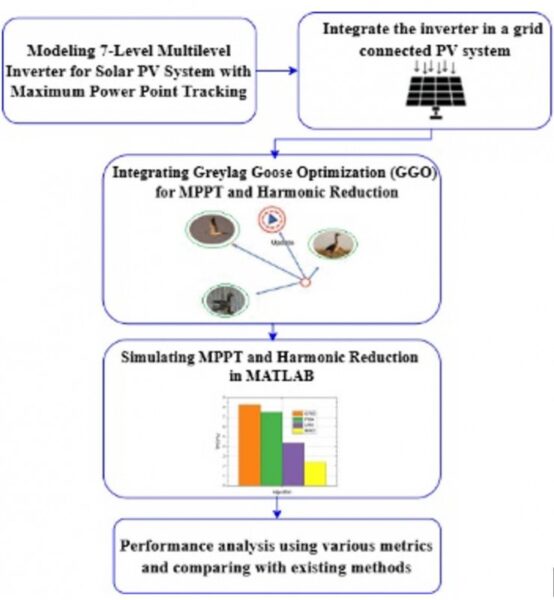Solar energy has long promised a sustainable solution for farmers looking to power irrigation pumps, storage facilities, and processing equipment. But standard solar photovoltaic (PV) systems often fall short, struggling to maintain peak efficiency under changing weather conditions. A new study from Annamalai University may have found a way to fix that—by taking inspiration from the flight patterns of greylag geese.
Published in Energy Storage and Saving, the research explores how a bio-inspired optimization method called Greylag Goose Optimization (GGO) can significantly improve solar PV performance. When combined with a specialized seven-level inverter, the system not only extracts more energy from sunlight but also delivers a steadier, higher-quality power supply—critical for protecting sensitive agricultural machinery.
A Smarter Way to Track the Sun
At the heart of the problem is how solar PV systems find and maintain their maximum power output. Traditional maximum power point tracking (MPPT) methods can be inefficient, especially when conditions fluctuate due to cloud cover, temperature shifts, or dust accumulation.
The GGO algorithm, inspired by how greylag geese adjust their formations to conserve energy during long migrations, continuously fine-tunes the operating point of a solar PV array. This allows it to adapt dynamically, optimizing energy capture in real-time.
“This study marks a pivotal advancement in renewable energy for agriculture,” said Dr. K. Rajaram, the study’s lead researcher. “By combining the GGO algorithm with a seven-level inverter, we’ve created a system that not only maximizes energy extraction but also guarantees a stable and high-quality power supply, essential for the smooth operation of agricultural machinery.”
Cleaner Power, Smoother Operations
Another challenge for agricultural energy use is the quality of the electricity being generated. Many standard inverters convert DC power from solar panels into AC power with high total harmonic distortion (THD), which can cause erratic performance in irrigation pumps, refrigeration units, and other farm equipment.
The researchers tackled this issue by integrating a seven-level inverter, which produces a smoother “staircase” AC waveform with fewer abrupt transitions. When paired with the GGO algorithm, the system achieved a remarkably low THD of just 1.95%—far outperforming alternative methods like salp swarm optimization (6.14%) and genetic algorithms (10.84%).
Real-World Impact for Farmers
For farmers, the implications are significant. A more efficient solar PV system means lower energy costs and reduced reliance on fossil fuels. More stable power also translates to fewer equipment failures and less downtime. Additionally, the system’s ability to switch seamlessly between grid-connected and off-grid modes makes it especially useful for rural agricultural settings with unreliable grid access.
Beyond individual farms, this technology could play a role in broader efforts to expand sustainable agriculture and energy independence. As the agricultural sector faces mounting pressure to cut carbon emissions and operate more efficiently, innovations like GGO-based optimization could provide a scalable, cost-effective solution.
What’s Next?
While the study focused on simulations, the next step is real-world implementation. Field tests under varying environmental conditions will be key to validating the technology’s long-term reliability and economic feasibility.
With the demand for smart, adaptable energy solutions growing, bio-inspired algorithms like GGO may become a crucial part of the renewable energy landscape. Whether it’s in the sky or on the farm, nature’s efficiency still has plenty to teach us.
Subscribe to our newsletter for more science and tech updates.
If our reporting has informed or inspired you, please consider making a donation. Every contribution, no matter the size, empowers us to continue delivering accurate, engaging, and trustworthy science and medical news. Independent journalism requires time, effort, and resources—your support ensures we can keep uncovering the stories that matter most to you.
Join us in making knowledge accessible and impactful. Thank you for standing with us!

